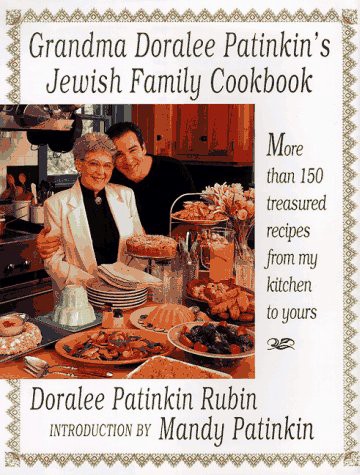In the Kitchen with Mandy Patinkin and His Mother, Doralee
Recipes from a Jewish grandmother
Think of Mandy Patinkin. Close your eyes and try to think of him as anything other than Saul Berenson, bearded and gruff and gravelly-voiced. Maybe you’re familiar with Mandy Patinkin from his star turn in “The Princess Bride.” Maybe you had no idea who he was until you saw “Homeland,” and spent at least an hour frantically researching, because there was something avuncular and kind that struck you about him and you needed to know more. Perhaps you’re harboring a tiny crush on him, only because you are imagining your life, some years from now, with a book and a cup of tea and a house with floorboards like honey, and he’s in there, piddling around in the kitchen, heating up a kugel. Or, maybe you just want all of that feeling, without any of the reality: warmth, security, a sense of patrician well-being that feels like love but is actually just a full stomach and a glass of wine.

Mandy Patinkin’s mother, Doralee, seems like a sweet woman who loves her kids. Her cookbook, “Grandma Doralee Patinkin’s Jewish Family Cookbook” is the physical proof of that love. The act of cooking for someone, even if it’s just some toast that you burned and a glass of water, is an act of love. Food is memory. A tuna sandwich on burnt wheat toast reminds you of afternoons home sick watching “The View”; chocolate chips pressed into peanut butter spread on top of Ritz crackers tastes much like the first time you got high. Remembering things via the food we eat is not new, but that notion gets lost sooner than you might think. “I wrote this book so that my children and grandchildren would always be able to say ‘Grandma always made this,’ and then know how to make it in their own kitchens,” Doralee writes in her intro. The food you grow up with is a legacy to pass down to your children, a physical piece of yourself that you can leave in this world when you die.
For years, my sisters and I have tried to get my mother to corral her recipes into something — a Google doc, or even an email chain would suffice. One of my sisters has taken this task on herself, and for a while, we almost had our shit together enough to make this thing a reality. The recipe for my mother’s “doggie bones” — spare ribs cooked in black bean sauce — is written on an envelope somewhere. One day, while cleaning out my desk, I discovered a notebook with a page or so of a dumpling recipe, next to my best friend’s mother’s recipe for stuffed cabbage, all tiny acts of self-preservation more than anything else. “I love just hunting through these pages looking for my childhood,” Mandy Patinkin writes in his introduction. “That, for me is one of the greatest things about this book: This part of my childhood isn’t lost.”

Each recipe in the book is accompanied with a quick note from Mandy’s mother — a personal anecdote about where they came from or who in the family enjoyed them the most. A sweet and sour sauce for poultry consisting solely of bottled sweet and sour sauce, white wine and ketchup is “an old family favorite”, preferred by Doralee and Aunties Lillian, Ida and June, too. A recipe for a childhood classic, hot dogs and baked beans, is served with pineapple chunks and mustard — a favorite at Temple parties and a special request from Mandy himself. Most cookbooks employ this tactic as a diversion, intended to distract from the fact that maybe, just maybe, the celebrity in question didn’t write the recipe. I firmly believe that Doralee Patinkin Rubin, mother of Mandy, wrote every single aside, sitting next to her son, looking over his shoulder and dictating as he dutifully typed her notes to send to the publisher.
The recipes of Mandy Patinkin’s childhood aren’t fancy, but they do look delicious. The dessert, cookies and cakes sections are a particular delight. If I were a parent in charge of say, supplying treats to a PTA bakeoff, this cookbook would make me a star. I lingered for weeks over the orange noodle kugel, a personal favorite of mine, but decided against it, knowing full well that if it were to reside in my home for longer than one day, I would eat it all. My lifelong fascination with gefilte fish led me to consider making my own, but the quantities of fresh fish it required proved too much for my budget. These weekly experiments are usually my lunch and dinner for the following week; I love pie and also cookies, but eating those for lunch is not the way to go.
I was going to make the kugel; I really love kugel. But, I made spinach lasagne instead, from the kitchen of Doralee’s dear friend, Ruth Kanter. The lasagne was made like any other lasagna is — noodles and cheese and sauce, layered in a baking dish and plopped in an oven for an hour or so. Lasagna is fussy work, but this lasagna, not so much. Instead of carefully draping just-cooked noodles over ricotta and sauce, I assembled the thing with raw noodles, and per the recipe, poured a cup of water along the edges and covered it with tinfoil. “That sounds gross,” a friend told me on Gchat, but I assure you it was not.